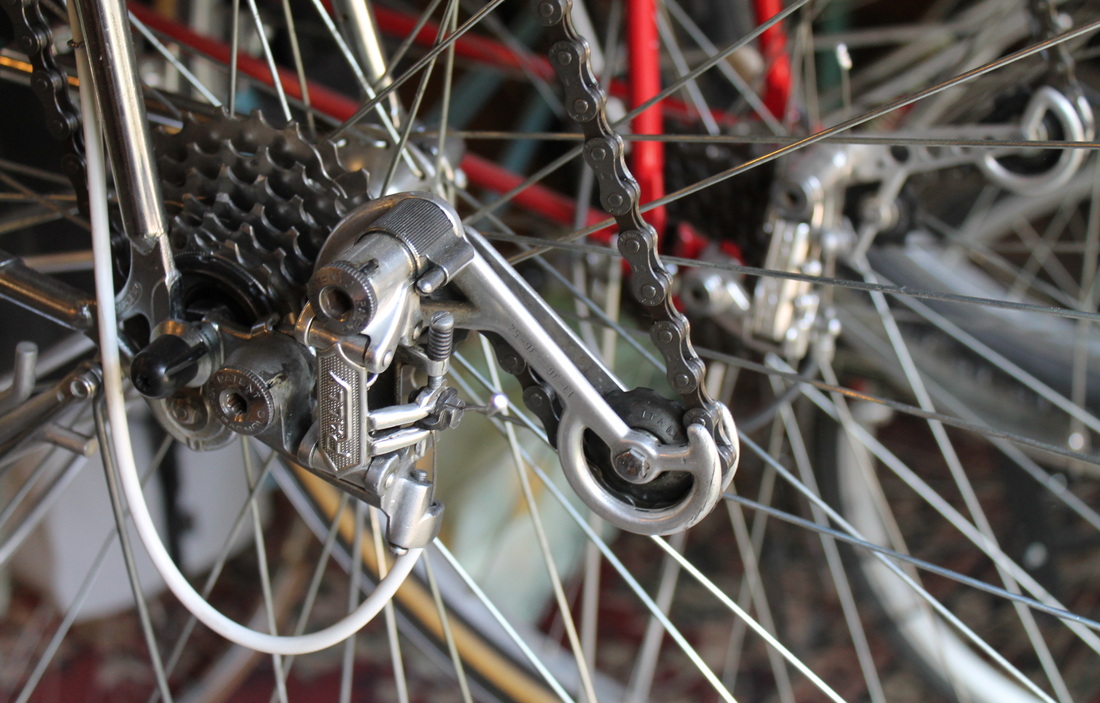I do miss the days before indexing and before Shimano ruled the world. There was a little more variety and that kept things interesting. The 70s and 80s brought us some very appealing and useful rear derailleurs. I’ve always been a tourer and commuter, not racer. And, thankfully, there were plenty of long-cage offerings during that period. Huret, Simplex, Campagnolo, Suntour, and Shimano all had respectable touring derailleurs.
Suntour made some excellent derailleurs and I have logged a lot of miles on the old V-GT Luxe. This was a light and durable touring derailleur. I used the same V-GT Luxe for 5 or 6 years of serious loaded touring before finally breaking the cage tension spring somewhere in Utah. Even then I was able to disassemble and manipulate the broken spring enough to make it work until I could reach Park City and replace it. In addition to my experience, I would say there is general consensus that the Suntour V-GT Luxe was a fine derailleur.
Not all vintage derailleurs have such broad support, however. The Huret Duopar is another touring derailleur from that era that is sometimes praised and other times maligned.
Recently, I was helping a friend of mine outfit a commuter bike he’s building. It’s an early 80s Trek originally setup with a titanium Huret Duopar. This Trek and its Duopar came matched to a wheel built with a Maillard Helicomatic. Not an uncommon combination for the time. If you’re not familiar with the Helicomatic hub, look it up. I remember when they first came out and having a shop owner show me the ease with which the freewheel could be removed using nothing but a little bottle opener tool.
The easy-off freewheel was intriguing for a touring cyclist. You see, replacing a rear drive-side spoke on tour meant you had to remove the freewheel to slide the broken spoke out and replace it with a new one. I’ve replaced a lot of spokes while on tour and often miles from civilization. To make this repair you had to carry a wrench big enough to fit the freewheel removal tool and give you the leverage necessary to break the freewheel loose. Something like a 10” Crescent wrench was the minimum requirement. With the Helicomatic you could use the bottle opener.
Unfortunately, the hubs turned out to be marginal. I used one for a short time and broke spokes. So I was glad the freewheel popped off easily. The other part of this hub was the proprietary Maillard freewheel. Trek sold touring models in the early 80s that included a Helicomatic and Maillard freewheel matched with a Huret Duopar. Again, the Helicomatic had its issues, but the Maillard freewheel was perhaps the real weak link in this combination.
The flat, non-profiled cogs on the Maillard spoiled the shifting performance of the Duopar. If you hear some old-timer complain about how poorly the Duopar shifted you could usually find a Maillard freewheel was an unmentioned part of that grievance.
I’ve used the Duopar off and on over the years and I think it is a good derailleur. I currently have Duopars on my Woodrup and my old Raleigh Competition. When matched with the modern ramped and profiled cogs on a Shimano Hyperglide, it shifts like butter. This leads me to the conclusion of this rambling post. An important but sometimes overlooked variable in the quality of shifting is the freewheel of cassette.
Because everything is indexed today, we take the profiled and ramped cogs for granted. But there was a time when French and Italian freewheel cogs were flat and square. Suntour freewheel cogs changed that. The teeth were tapered and sometimes slightly twisted to help grab the chain during gear changes. Not to take anything away from Suntour, but at least some of their reputation for great shifting originates with their improved freewheel design.
So, next time you get into a debate about the comparative shifting quality of vintage derailleurs, be sure to check the freewheel.






 RSS Feed
RSS Feed
